After the sacking of Mauricio Pochetino, much has been made of Jose Mourinho’s appointment at Tottenham Hotspur. After a troubled English Premier League start, Spurs finally made the decision to part ways and bring a new manager to steady a sinking ship.
As it being Mourinho’s third game in charge, opposition Bournemouth FC had a lot of confidence. New teams under new managers are prone to mistakes and Bournemouth came into this match looking for blood and victory.
In this tactical analysis, we will analyze the tactics behind Mourinho’s Spurs and Eddie Howe’s Bournemouth. Moreover, we will have an analysis of why Spurs beat Bournemouth 3-2.
Lineups
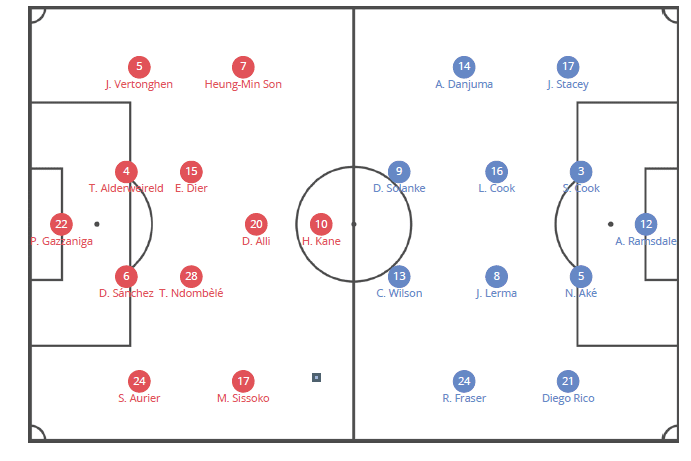
Mourinho made three changes to the side that defeated West Ham 3-2. Ben Davies was dropped due to injury and veteran Jan Vertonghen made his way into the left-back position. Centre midfielder Harry Winks was rested by Tanguy Ndombele while attacking midfielder Lucas Moura was dropped for Mousa Sissoko. The Portuguese kept the formation, 4-2-3-1, intact.
On the other hand, Howe instituted a formation change, changing his 3-4-3 that lost to Wolves to a 4-4-2. Howe also made four total changes, introducing in Jack Stacey for Simon Francis – who was red-carded. Central midfielder Adam Smith was replaced by Jefferson Lerma while another central midfielder Philip Billing was replaced by Arnaut Danjuma. Finally, Harry Wilson was dropped for Dominic Solanke.
Spurs’ asymmetric formation and buildup creates space in the centre
Mourinho’s arrival at Spurs has meant quite a few changes for the Lilywhites. What used to be a 4-3-3 that relied on the intricate build-up and an infusion of midfield physicality has turned into a 4-2-3-1 (oftentimes looking as a 4-4-1-1).
So how does this new midfield work, especially in buildup?
The first change is for the back four to split into a back three with the right-back Serge Aurier going upfield as a wing-back. Makeshift left-back Jan Vertonghen narrows his position to make a back three with fellow centre-backs Toby Alderweirld and Davidson Sanchez.
Up ahead this three-man backline was a pivot consisting of Eric Dier and Tanguy Ndombele – both people with different profiles that transferred into a different working of the buildup scenario.
Whereas normally 4-2-3-1, like that of Chelsea, has the pivot symmetrically set up, Mourinho’s Spurs employ an asymmetric situation. The more technical of the pivot, Ndombele, shifts central to act as the central defensive midfielder that helps facilitate play from defence to midfield.
On the other hand, Dier shifts to whichever side he sees space opening upon. This asymmetric buildup set-up often leaves one side loaded with players while the other side has few players.

Here we see the three-man backline of Spurs. Moreover, Ndombele occupies the centre of the pitch, catching attention from two Bournemouth forwards. To the left of him stays Dier – not being in a symmetric position but rather one which makes, in this case, Spurs lopsided on the right-hand side.
However, Mourinho chose one side to more lopsided than the other.
With the attacking profiles of Spurs, and with intention of just winning right now, Mourinho has the attack loaded on the left-hand side of the pitch where the likes of Heung-Min Son, Dele Alli, and Harry Kane.
There are tactical benefits behind this asymmetric buildup and structure.
Asymmetric formations often disrupt the more symmetric formations and tactical setups. Bournemouth had lined up in a symmetric 4-4-2 which meant a set-up that prioritizes one flank would unnaturally position The Cherries which would create space for the attackers.
Looking at the attacks that occurred in the whole game, Spurs attacked via the left-wing 15 out the 52 attacks equating to an xG of 0.96. This pales in comparison to the statistics on the right-wing with only three attacks occurring with an xG of 0.06.
Having play occur on the left-hand side, the Cherries would be attracted in unnatural ways which in turn would create space in the middle. This space in the middle allows any team to directly attack the defence and as such, force the defensive line to be shifted and as a result, create space behind the line.
To facilitate this better, wide-midfielder Moussa Sissoko shifted from his position inwards to be available as a passing option. As such, Spurs had an additional person to attack through the centre.
Combine this with Ndombele’s advanced position and all of a sudden, Spurs had a credible attack going through the centre. Ndombele’s profile, which exists of an exquisite passer and an excellent dribbler, meant that Spurs had a deep-lying playmaker of sorts that could see the runs of Alli and Kane.
This ability to attack through the centre in the final stages was evident. Spurs played 29 of their 52 attacks through the centre with an xG of 1.16 – a statistic that indicates that Spurs were targeting this asymmetric approach to create space in the centre.

Here, the three main attackers of Spurs overloading on the left-hand side. This proximity and asymmetric setup has shifted Bournemouth’s defence to the left-hand side as well. While there is one Spurs player being man-marked, this has left Bournemouth short on the left-wing flank.
Moreover, the centre is now undefended meaning that Spurs can play back and quickly attack though the middle of the pitch and then find the un-marked Spurs player free on the wings in preparation for a cross or cutback.
A left-handed approach allowed for the biggest tactical set-up to happen: free interplay and movement of Alli and Son.
Both Alli and Son played together and as such, benefit from an intelligent interplay that not only disrupted Bournemouth’s defensive set-up on the right-hand side. This fluid play worked to constantly introduce decoy midfield runs and play-offs between each other that often distracted defenders.
In the case of the first goal, this relationship worked to delay some defender’s runs and distract their attention to allow for Alli to have space to score the goal.

Before the ball gets launched, Son here, on the far right, starts a curved run. This initial fast run gives him the edge on the Bournemouth full-back. Alli, sits slightly deep, to cause the centre-back to also follow deep. This is advantageous as when Alli starts the run, the centre-back will have to shift his weight and turn around, giving Alli a head start on the defender.

Son’s run here attracts two Bournemouth defenders. Alli, as talked about before, now has a headstart over his defender and is ahead of him.
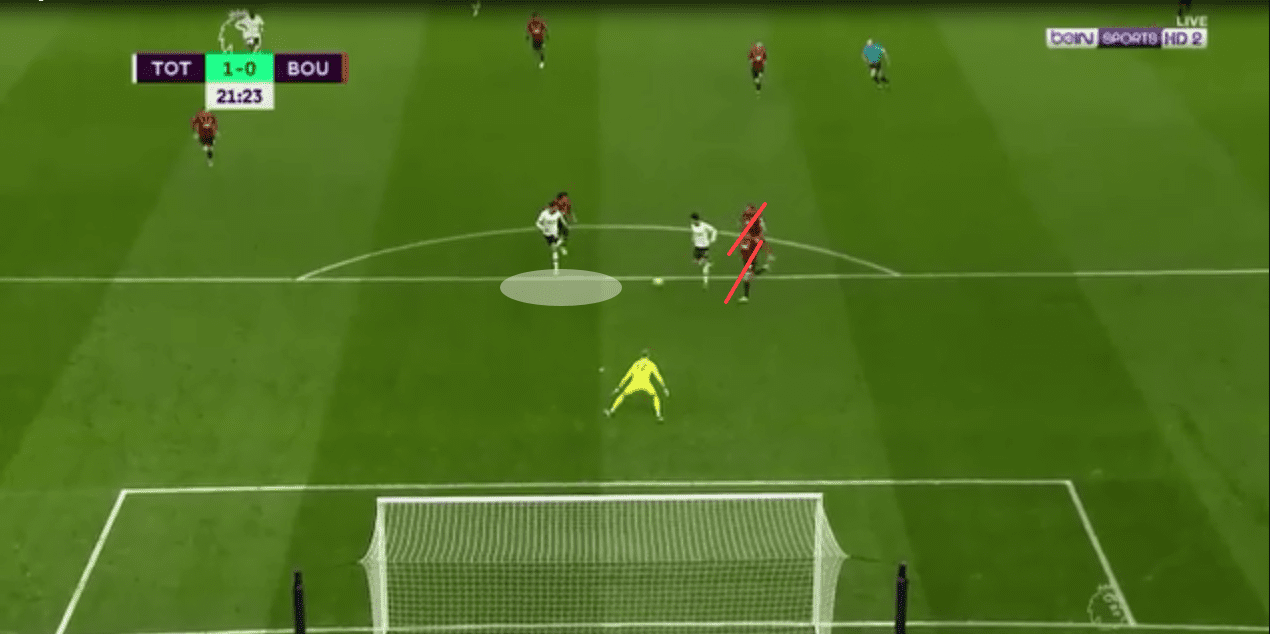
Son’s first touch eliminates the two Bournemouth defenders creating space for Alli in the centre to exploit. Having gotten ahead of his defender, Alli simply has to choose where he wants to score and score he does.
Bournemouth look to exploit half-space between the Spurs’ line
Equally engaged in the attack were the Cherries. Recording a total xG of 1.26, the Cherries constantly looked some part of a threat.
Their main plan of attack was to exploit the pocket of spaces left between the Spurs’ fullback and centre-back. There were good tactical reasons for exploiting this space on both left and right-hand side.
On the left, Vertonghen has not played left-back as usual and as such, there is bound to be some misunderstanding between him and centre-back Aldeirweirld. Bournemouth wanted to exploit this relationship as much as possible.
On the right, Sanchez and Aurier have not played as many games in this new relationship. Moreover, Aurier was the full-back that went upfield meaning in a counter-attack, Bournemouth could attack the space he left and drag out Sanchez to create space in the half-space.
Their main-method of this exploitation involved working in tight spaces – having one person on the touchline, one person in the actual halfspace, and a few people behind to support this attack.
From here, Bournemouth would shift the defence through small passes and switch the play on the other side, hoping that a simple combination of two players would be able to exploit the halfspace.
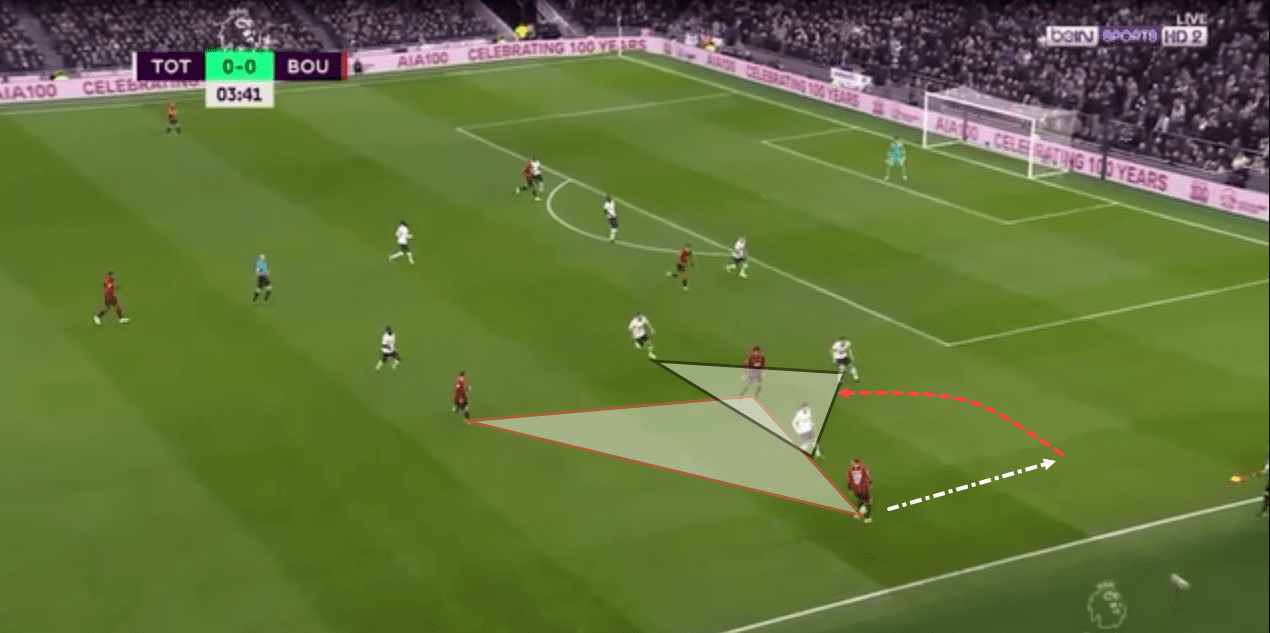
In this picture, we see the setup as described before. One player hugs the touchline while another situates himself in the half-space. Another player comes in behind to support these two.
This triangle works against the triangle of Spurs. Here, a simple run by the wide player will largen this Spurs triangle allowing him to slip a pass into the half-space.
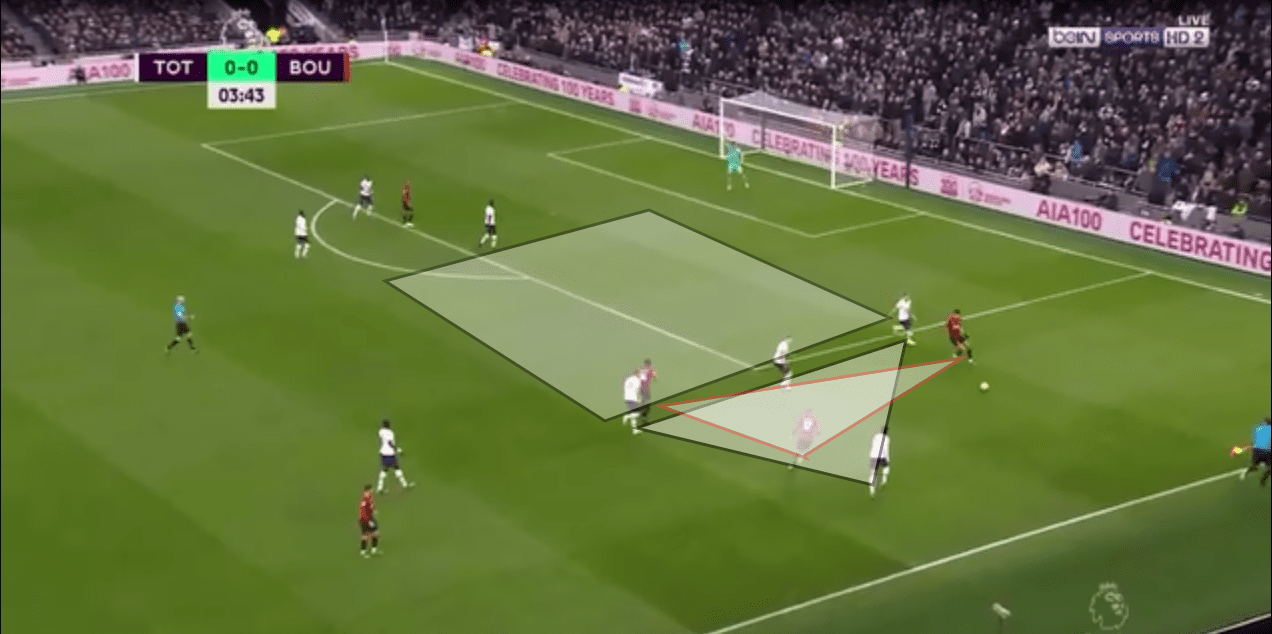
Here the ball has been played into the half-space and now the Cherries have accomplished what they wanted. They have moved Spurs’ defence to the right via these short passes to create space between the defensive line. Bournemouth’s triangle, now, allows them to play through and access this space and attack.

Here the Spurs’ right-hand side defence is now unnaturally congested into a small space. With the ball being played into the centre, Howe’s men have two choices. Either the recipient of the ball can touch and try to slip a goal in or play a first-time chipped pass to the wing where there is a big space unoccupied and unmarked.
However, this methodology of attacking did not work as expected in the first half.
Bournemouth only ended up recording an xG of 0.29. This failure occurred due to the positioning of the two wide midfielders, Ryan Fraser and Arnaut Danjuma. Fraser positioned himself in the left half-space but the problem was that more often than not, he was isolated and as such, not able to affect the game.
Danjuma, on the other hand, played too central and as such, Bournemouth were not able to develop play on the right-hand side. Their midfielder who was supposed to stretch the defence was playing through the middle, an area where Spurs had the maximum number of people.
This set-up changed in the second half with the substitution of Harry Wilson in the 63rd minute. Danjuma was shifted to the left-hand side and Wilson came into the right-hand side. Wilson immediately occupied a much higher position than Danjuma, making himself close to the striker.
All of a sudden, Bournemouth’s xG started rising. At the 63rd minute, Bournemouth barely an xG of 0.5. However, after the substitution, Bournemouth’s xG steadily started rising. The impact of Wilson was immediate.
He allowed Bournemouth to have a passing outlet on the right-hand side but also didn’t lose the ball meaning that the Cherries could now fully develop their attack as opposed to Fraser’s ball dispossessions and failed passes.
Dele Alli’s role causes a nuisance for Bournemouth’s defence
A constant thorn in the side of the Cherries was Dele Alli. Despite having only played three games under Mourinho, the midfielder has started to reap the benefits of this new tactical change.
For one, Alli has been given complete freedom in his role – this is evident with his position right behind the striker.
This role of playing behind the striker has allowed him ample space to function – allowing his full abilities to be used to the greatest extent.
One of his major roles consisted of finding gaps between the midfield lines and inserting himself in these spaces to create passing lanes for the Spurs midfield. Alli’s constant observance of these gaps allowed him to constantly allow Spurs to bypass the Cherries’ midfield.
Moreover, his interactions with Son turned out to be critical as they constantly played off each other to bring out the defence as to create space behind them. This occurred via the positions of these two players.
Son would position himself wide on the wing while Alli would move into the halfspaces. Beneath this duo would be a Spurs midfield, more often than not Dier. This small little triangle has various tactical considerations.
The first one concerns Alli. With his normal position higher up, he would drop down to form the triangle with the players. This dropping deep would draw some Cherries players which created space in the central corridor.
With Son being wide, the fullback and accompanying opposition midfielder were forced to divide themselves up as to control the situation. This opening in the space would then be occupied by curved runs by either Son or Alli.
Combinations like these allowed Spurs to create holes and take advantage of where there were none.
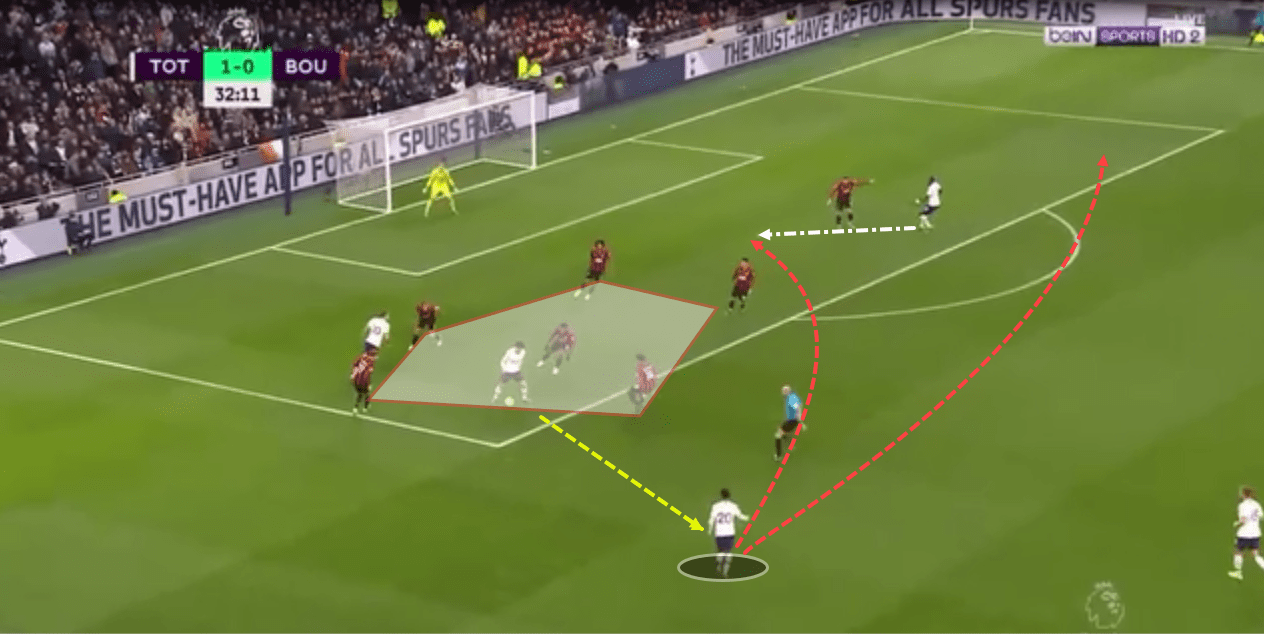
Alli has dropped deep and made himself free. As talked about before, Mourinho’s men have lopsided the play on the left-hand side which has congested Howe’s men.
Now, Alli has many options. He can try to curve a pass to the flanks to try to create a 1v1 scenario for crossing. Another option for Alli is to curve in the centre and try to find a runner.
It is this penchant to look for combinations and space – which makes him a ramdeuter (German for “space interpreter” – that made Alli a constant threat against Bournemouth.
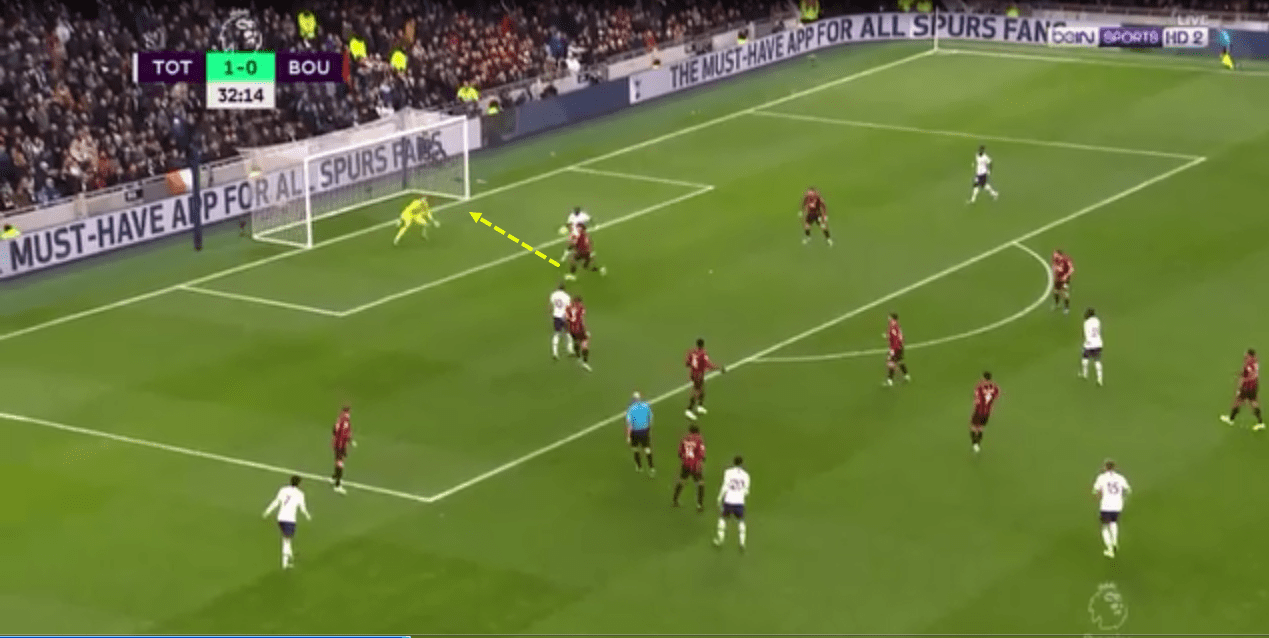
Here is the final result of Alli’s ball. It does find a runner but the attacker is a step off allowing the Cherries defender to clear the ball. However, if the attacker had started his run early, Alli’s pass would have allowed Mourinho to get another goal.
Another important facet of Alli was his runs. As discussed before, whenever Spurs would start attacking, they would assume a three at the back formation.
All three centre backs of Spurs are great long passers of the ball, able to spray long and accurate long balls. In fact, the three centre-backs contributed to ten long balls whose intended target was the final third.
Alli’s runs were a natural complement to this long-ball playmaking. His constant movement that he was always making curved runs, hoping to meet some of the long balls. Aside from using those long balls to score goals, as he did with the second goal, he also wanted to use this combination to create space in the centre and allow Spurs to instantaneously land themselves in the opponent’s half without the more intricate play-making of the buildup.
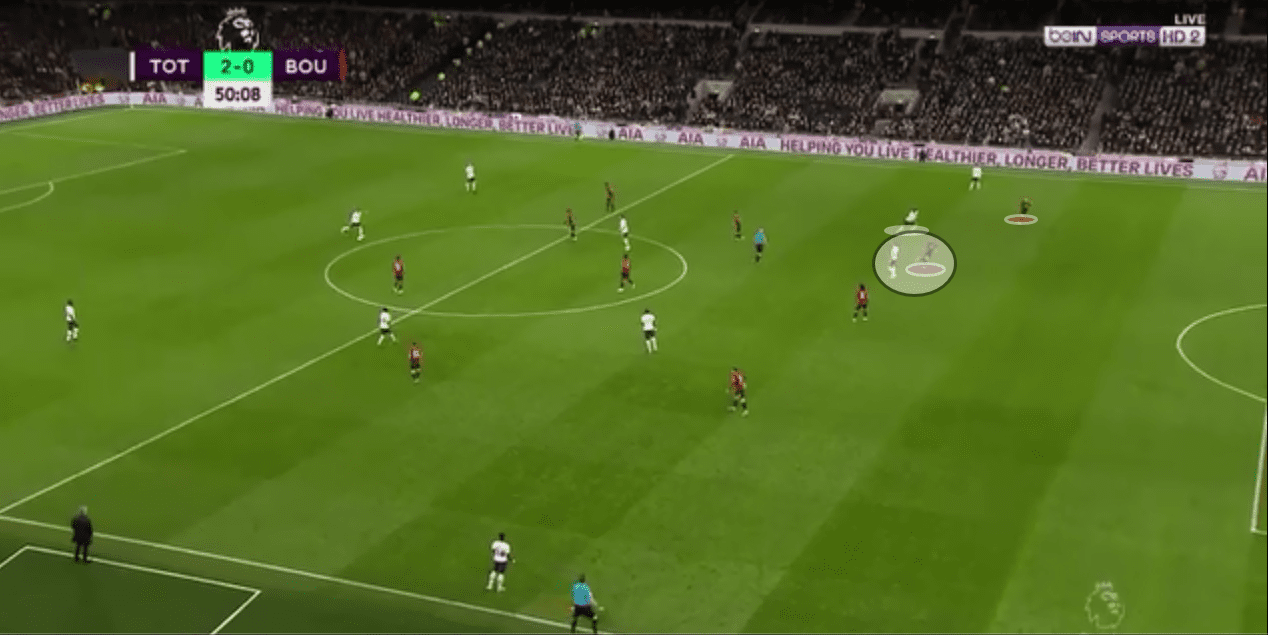
Here is an analysis of Alli’s second goal. As is characteristic, he starts his run early which catches the Bournemouth defender off-guard. Additionally, Kane’s presence pins the second defender making this defender’s run a little late.
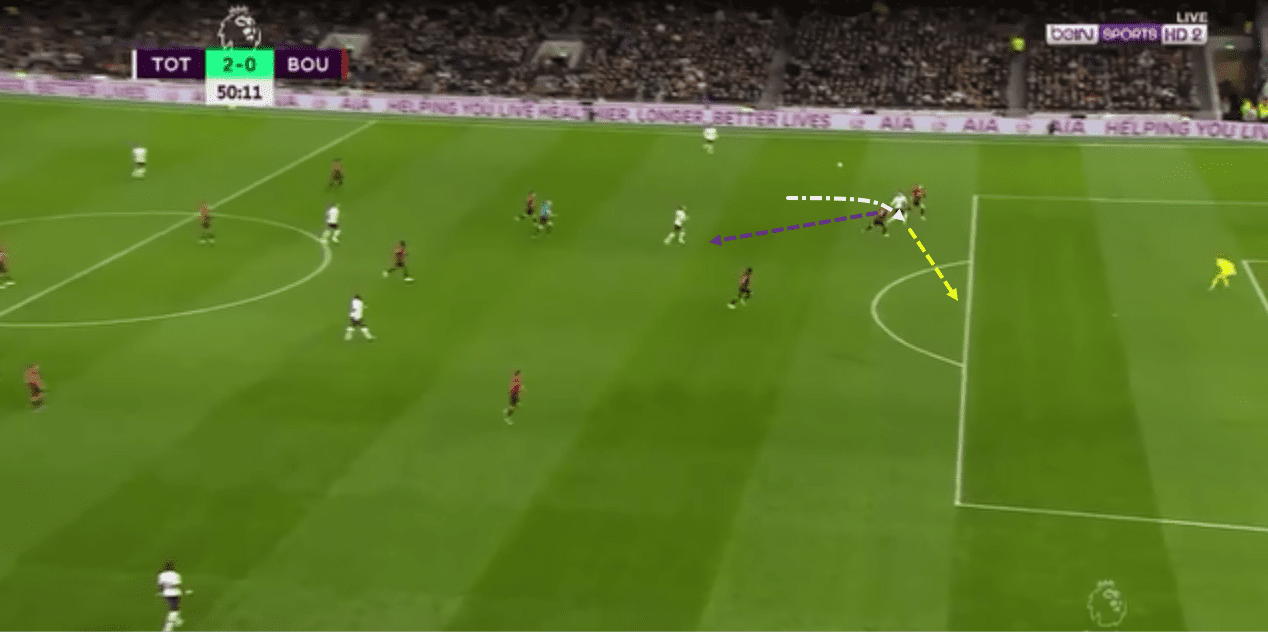
Due to those aspects, Alli has squeezed himself in and now has two options. He can either take a touch outward into space and get 1v1 with the goalkeeper or head it back to Kane who can then develop the attack through the centre.
In this case, Alli goes outward and scores the second goal for the Lilywhites.
Conclusion
While two late Harry Wilson goals lead what was a comfortable lead into dangerous territory, Mourinho and his Spurs should be proud of the game. Not only did they create various chances – as shown by xG – they did this without letting Bournemouth sniff many chances of the goal.
One thing that should concern the Portuguese veteran is Spurs’ vulnerability on the left-hand side.
On the other side, the Cherries should look at their attacking plan much more carefully. Moreover, Howe will have to reconsider his attacking line-up seeing the impact that Wilson brought on.

If you love tactical analysis, then you’ll love the digital magazines from totalfootballanalysis.com – a guaranteed 100+ pages of pure tactical analysis covering topics from the Premier League, Serie A, La Liga, Bundesliga and many, many more. Buy your copy of the November issue for just ₤4.99 here




Comments